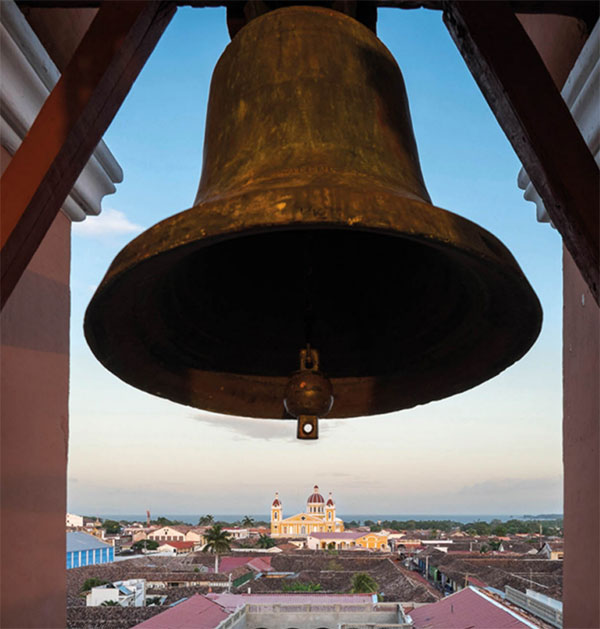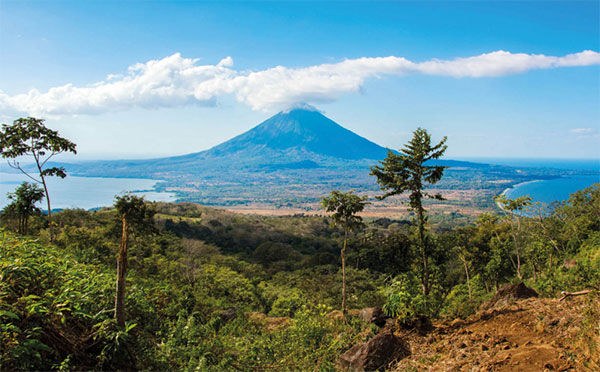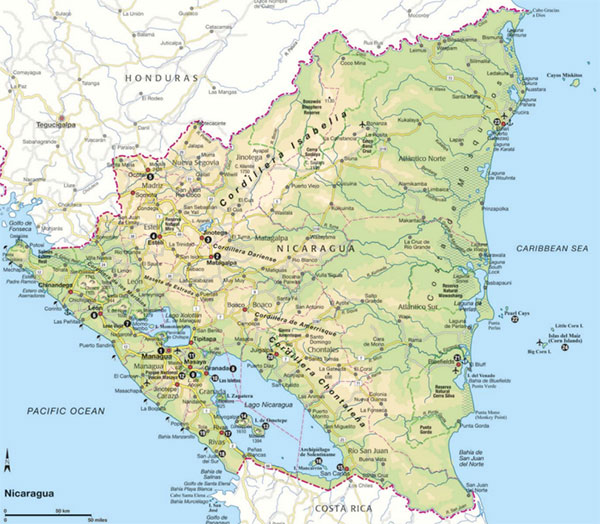NICARAGUA
A land of contrasts, Nicaragua is Central America’s sweet spot with all of the culture and nature, yet few of the tourists.
Main Attractions
Léon
Granada
Isla de Ometepe
Solentiname Archipeligo
San Juan del Sur
Corn Islands
Costa Esmeralda
Word is quickly getting out about Nicaragua, long off the radar for all but the hardiest of travelers to Central America.

Looking out over the roofs of Granada and the Cathedral from the bell tower of Iglesia La Merced.
Getty Images
With 78 protected areas covering over 20 percent of the country, which is even more than Costa Rica, and home to seven percent of the world’s biodiversity, there is masses to explore here. While the effects of the Sandinista insurrection and several natural disasters will linger for the foreseeable future, the country’s tourism infrastructure has been on the up for years.
Along the Pacific coast, luxe resorts north of the former fishing village-turned-surf hangout San Juan del Sur can now be accessed by an airport, Costa Esmeralda, a name that follows a new marketing strategy. The faded architecture of colonial cities like Granada and León is being given a facelift, with boutique hotels and cafés moving in by the dozen. Expats, priced out of Costa Rica, are finding their way here, taking advantage of the inexpensive healthcare, not to mention the excellent rum and cigars.
Ecotourism continues to be an important enticement, with sandboarding down the slopes of Cerro Negro and the smoking crater of Masaya major geological attractions. Hikes through cloud forests, dry forests, and lowland tropical forests reveal a country swarming with wildlife. If you get tired of canopy tours, which are now a dime a dozen, there are organic farms reached only by horseback and kayaking excursions with caimans to sample.
While a potential canal may one day cut through the Caribbean coast and turn Lake Nicaragua into a major shipping route, for the time being Isla de Ometepe remains a place for volunteerism and excellent coffee. Other corners of the lake, like the artist colony on the Solentiname Archipelago and the wild islets in the north, remain much as they were decades ago. Along the Caribbean coast and farther afield on the Corn Islands, the vibe is even more relaxed, with days filled with swaying palms and snorkeling and nights vibrating to the beat of an African drum.

Concepción volcano and Ometepe island.
iStock

The post-war period
Weary of war, Nicaraguans voted out the Sandinistas in 1990 in a surprise victory for Violeta Chamorro, the widow of journalist Pedro Joaquín Chamorro Cardenal, who became Nicaragua’s first female president. With the economy devastated and a series of natural disasters unfolding shortly after, such as a 1992 earthquake and 1998’s Hurricane Mitch, Nicaragua saw few major improvements in the years subsequent to Sandinista rule.
In 2006, Sandinista Daniel Ortega returned to power and was reelected in a landslide in 2011. In 2014, the congress adjusted the constitution so he would be able to run for a third term, which he won by a large margin in 2016. He then won again in the 2021 elections. The general economic stability from Ortega’s social programs and business-friendly environment has been widely popular among Nicaraguans who are eager to put the past behind them. With an economy growing at double the Latin American average and a society avoiding the violence of Honduras to the north, Nicaragua appears to be in better shape than it has ever been. Still, many opponents claim that the election was a farce and that the growing autocracy, pushed by Ortega’s vice president and wife, Rosario Murillo, is keeping it from becoming truly democratic.
Managua and around
Named Nicaragua’s capital in 1852, ending the rivalry between León and Granada and setting up extensive urbanization for the next 80 years, more than two million people call Managua 1 [map] home. Set on the shores of Lago Xolotlán, aka Lake Managua, parts of the city feel like the apocalypse has hit, with empty lots filled with rubble and swaths being overtaken by jungle. Much of this disorder can be traced back to December 23, 1972, when an earthquake flattened 8 sq km (3 sq miles) of the city, killing an estimated 10,000 people. Before anything could be rebuilt, revolution came and bombings knocked down buildings and sent the city’s wealthy fleeing to Miami. Only in the 21st century, as the economy has begun to stabilize, has Managua seen efforts to bring it into the modern era.
While most travelers hightail it out of the city immediately upon landing, especially with Granada being just a short drive away, those who do spend a day or two in Managua will find a major Central American city that is essentially free of tourists. The center of the city, the Zona Monumental, is where the majority of attractions and government buildings can be found. However, this neighborhood was badly damaged in the 1972 earthquake and can be dangerous outside of daylight hours.